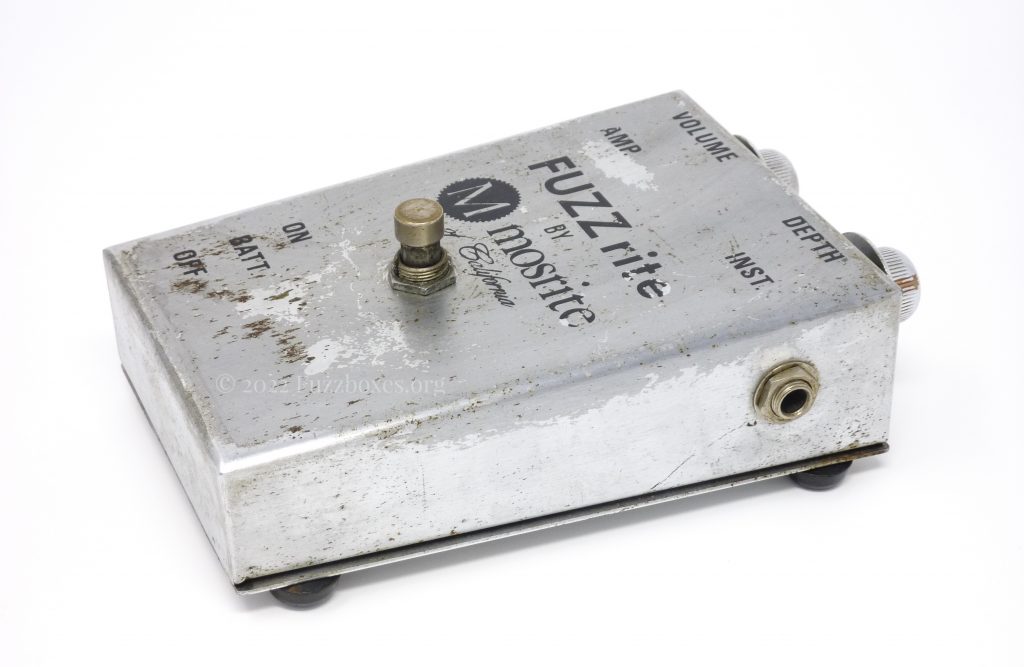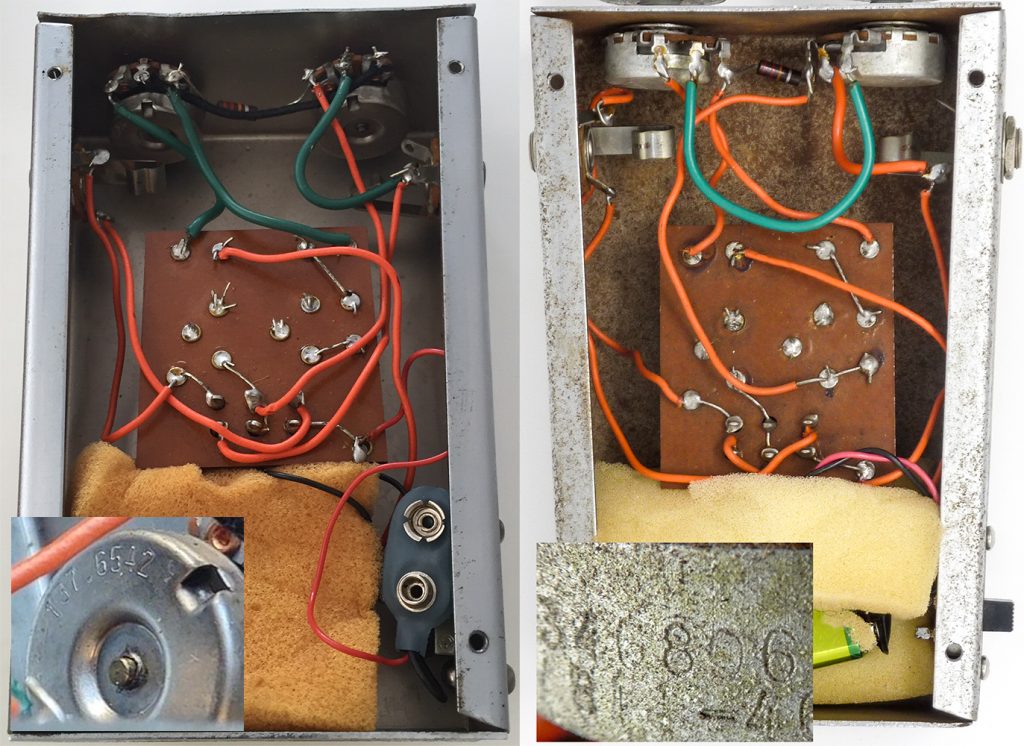- Background
- Myth-busting
- Analysis of the Fuzzrite’s graphics
- Tech specs
- Production numbers
- Future of the Fuzzrite
Background
The Mosrite guitar company was founded in Bakersfield, CA, in 1956, by brothers Semie & Andy Moseley, thanks to an investment from Ray Boatright. The name, ‘Mosrite’, was a portmanteau of these two entities. It wasn’t until Mosrite assembly-line inspector, Eugene Moles, met Nokie Edwards in the early 1960s, that the company became involved with the Ventures, and ultimately started offering the various signature models.1
Ed Sanner was reputedly involved with Mosrite by 1965, developing circuits for a range of amplifiers that they planned on offering, in addition to the guitars.2 Sanner recalls supplying steel guitar player, Leo LeBlanc, with a custom-made fuzzbox, and subsequently Semie became interested in manufacturing this as what would eventually become the Mosrite Fuzzrite.3
It is unknown exactly when the Fuzzrite came on the market. Over the course of several years, the Fuzzrite underwent numerous cosmetic changes, as well as technical changes to the circuit. Analysis of surviving Fuzzrite pedals suggests that production of Mosrite’s fuzz box began at some point in mid-to-late 1966, and continued through 1968, presumably until the time when the company infamously went bankrupt. Despite a relatively short-lived original production run, the Fuzzrite proved to be an influential fuzz box design, and it spawned numerous imitations, as well as official reissues, over the years and decades to come.
Myth-busting
There are two distinctly different versions of the Mosrite Fuzzrite that were being built during the period of 1966-1968. Earlier Fuzzrites were built with a set of 2N2613 & 2N408 germanium transistors, while later versions used silicon transistors, across a variety of different construction methods.
For a long time, there was a common belief circulating the various Internet forums that the earlier, germanium-transistor Fuzzrites were built in considerably smaller numbers than the silicon versions. Ed Sanner recalled Mosrite having shipped “around 200 [Fuzzrites]” before they realised that the innate temperature-sensitivity of germanium transistors was leading to problems with the fuzz sound.4 In another interview, at some point in the early 2000s, Sanner also gave the number of germanium-transistor Fuzzrites produced, as ‘250’, and cited the same problem of temperature-sensitivity being the catalyst for the move to the silicon-transistor design.5
Extensive study of the technical details of the germanium version of the Fuzzrite casts some doubt over this narrative. The following sections explore the development of the germanium-transistor Fuzzrite in greater detail, and furthers the possibility that this ‘temperature-sensitive’ model is not quite as rare as some dealers and collectors like to think.
Analysis of the Fuzzrite’s graphics
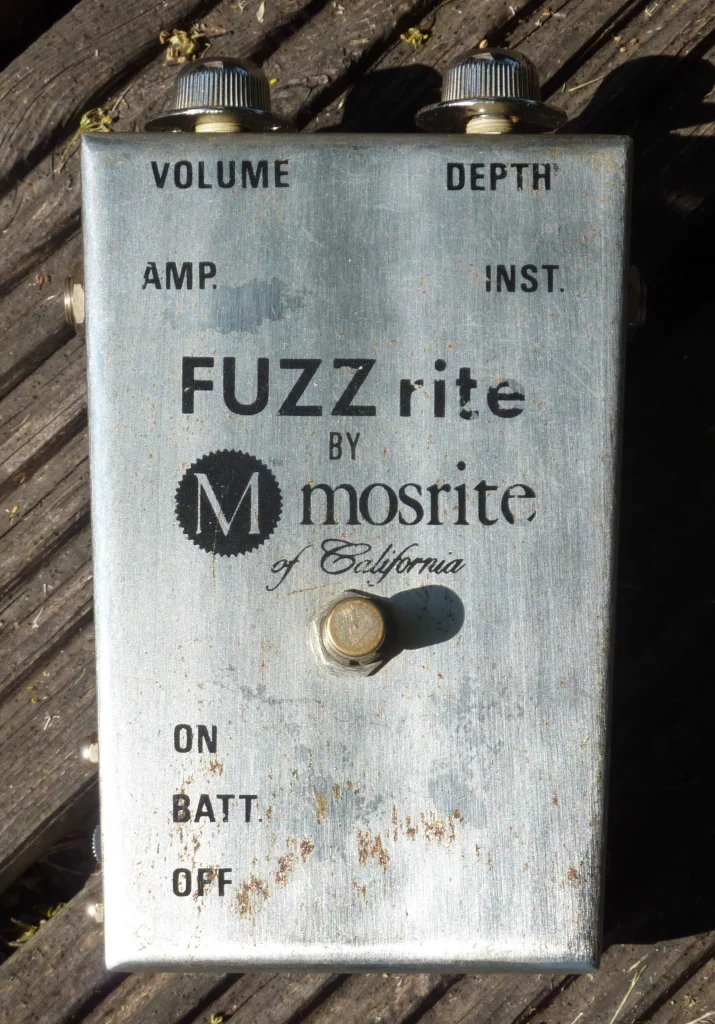
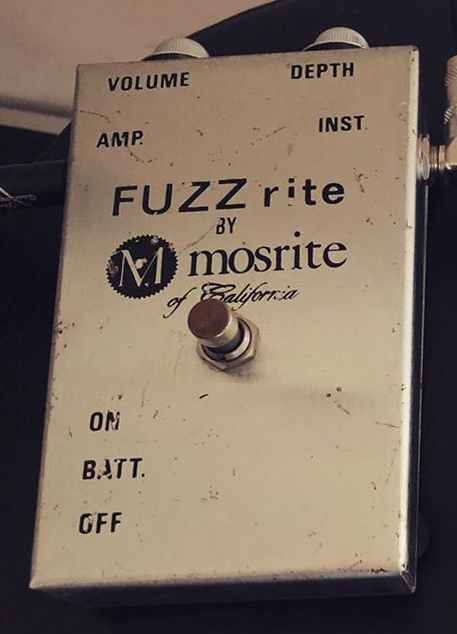
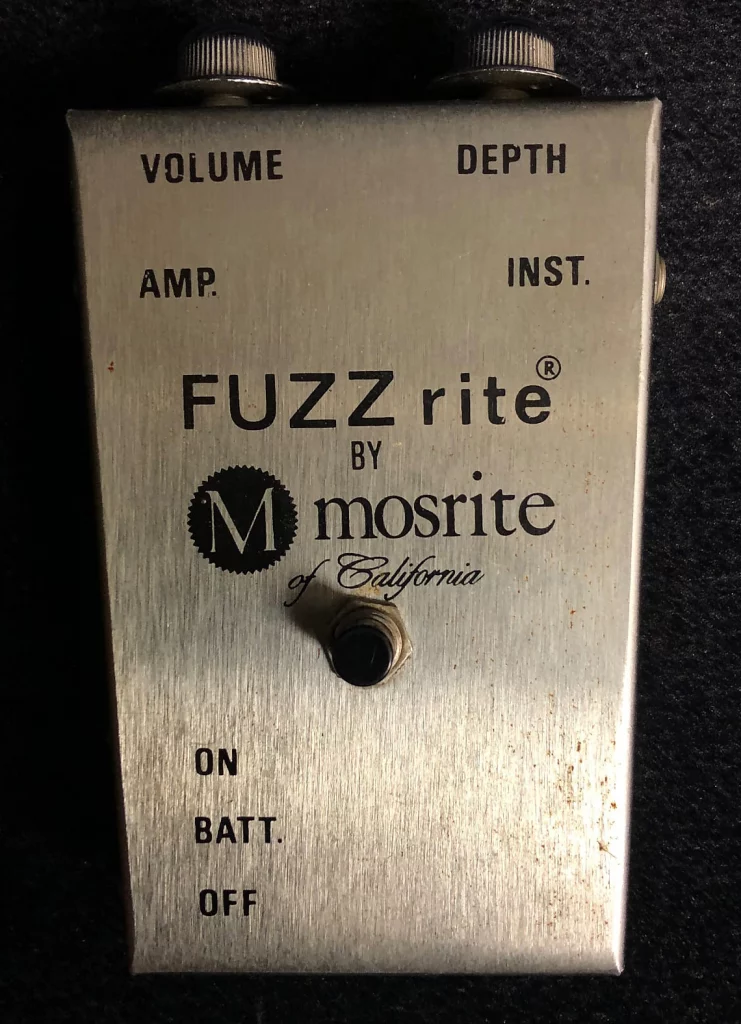
Before diving into the technical specifications of the various different versions of the Mosrite Fuzzrite, it’s useful to examine the way that screen-printed graphics on the Fuzzrite casings changed over the years. This is because the changes Mosrite made to the graphics on the enclosures generally correlate with the changes that Mosrite made to the circuitry inside, and with the date codes stamped on components. We can use this information to place surviving pedals into a logical chronology.
Mosrite produced at least three different versions of the graphics that the Fuzzrites’ enclosures were printed with between 1966 and 1968. Examples of the three versions are pictured above. The first two versions are almost indistinguishable, other than that the typeface for the ‘FUZZrite’ lettering differs. The third version was the same as the second, but featured the ‘®’ symbol, denoting that the Fuzzrite was now a registered trademark of Moseley’s. (Photo credit: K. Higasayama/kunihito1226; S. Lee/freddy_von; unknown)
Tech specs
Mosrite Fuzzrite (perf board version), c. 1966
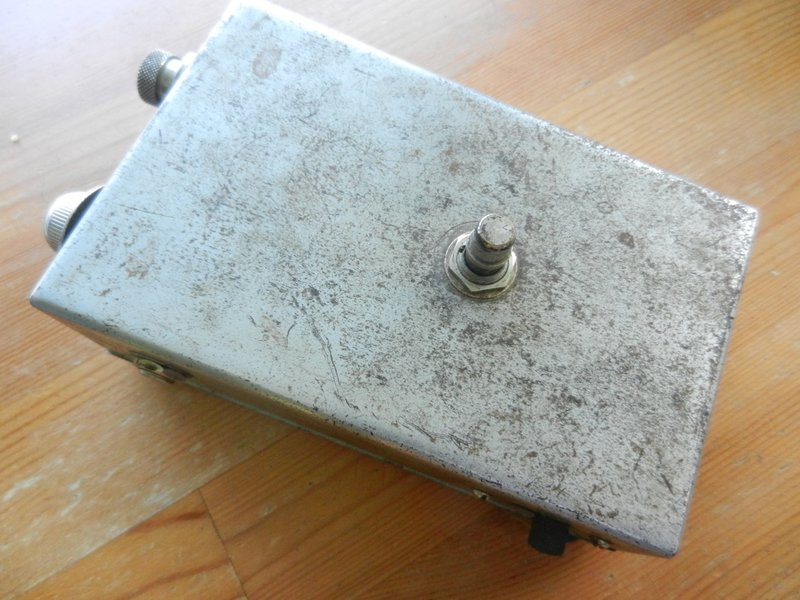
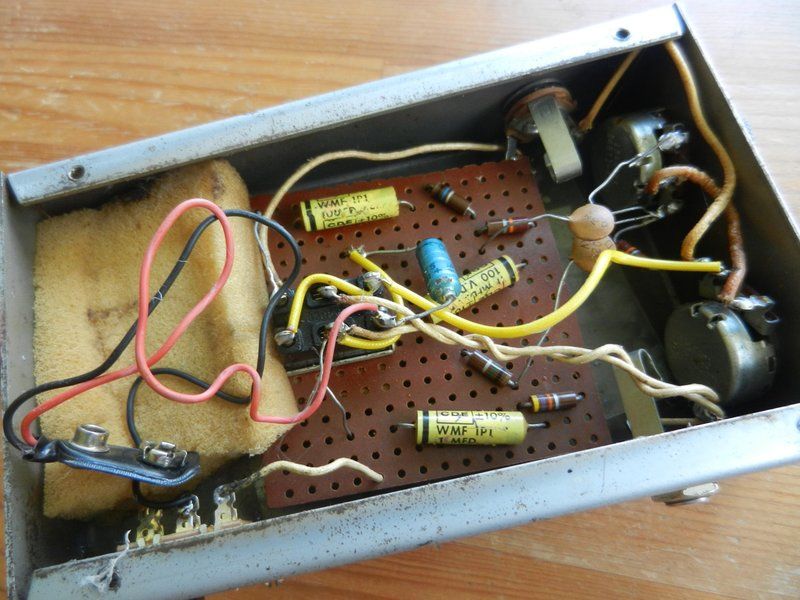
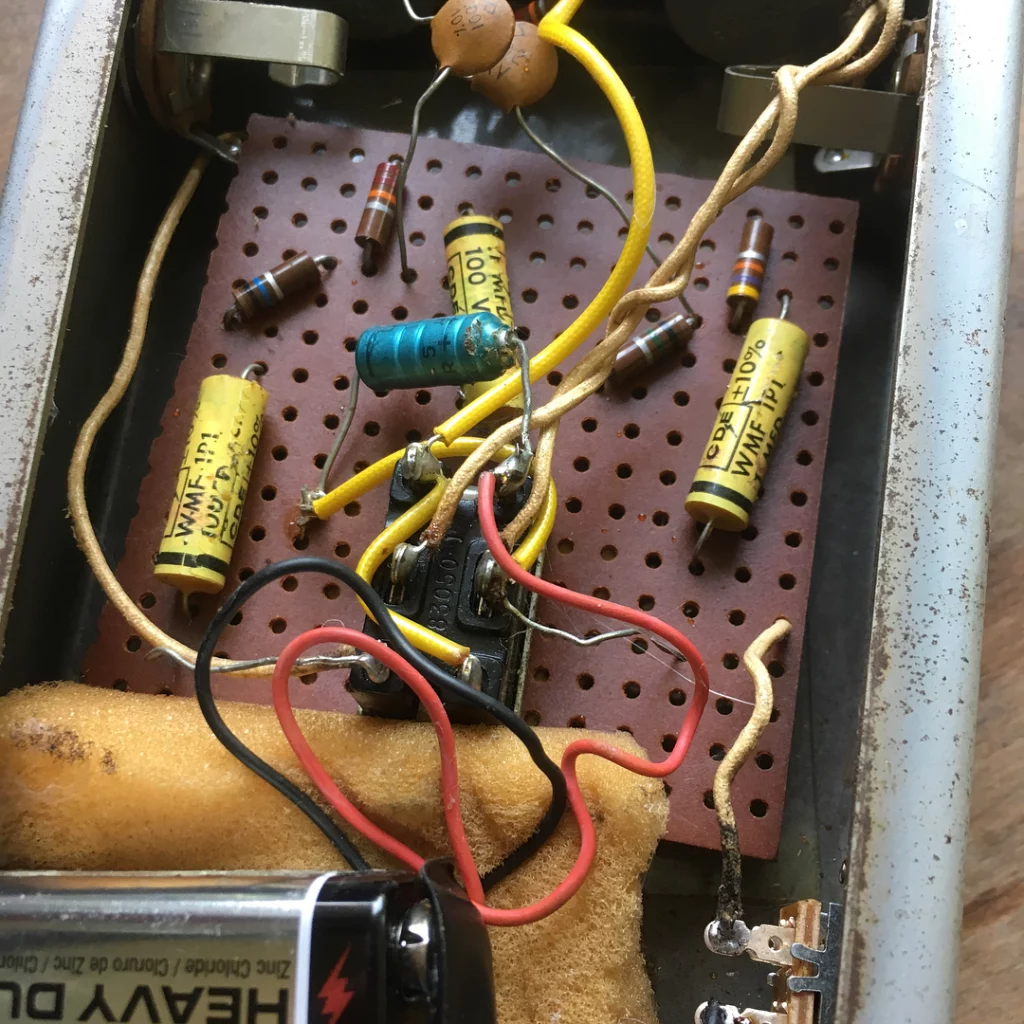
The earliest known version of the Mosrite Fuzzrite was built point-to-point, on perforated circuit board. These Fuzzrites are among the rarest versions, and as a result, there’s only very limited data available about them. (Photo credit: J. Roth/jermsfuzz)
The 100nF input, output & coupling capacitors on these perf board Fuzzrites were manufactured by Cornell Dubilier. CDE capacitors have yet to be seen in any other version of the Fuzzrite, but again, this could be a result of only having little available information at the time of writing. There are only two sets of potentiometer date codes known from the very small sample of surviving perf board Fuzzrites, and both sets read the 23rd week of 1966.
The bushing of the perf board Fuzzrite’s footswitch feeds through the circuit board, and a small block of wood was secured around the switch, acting as a physical spacer between the circuit board and the enclosure. A sheet of clear plastic runs across the underside of the board, which also helped to prevent a short-circuit.
Early Fuzzrites were particularly susceptible to having their lettering worn away, as demonstrated by the example pictured above. Only one surviving perf board Fuzzrite is known to have any of its original screen-printed graphics remaining, and the little lettering that is left resembles the very first version of the Fuzzrite graphics.
Mosrite Fuzzrite (phenolic paper, “reversed” version), c. 1966-1967
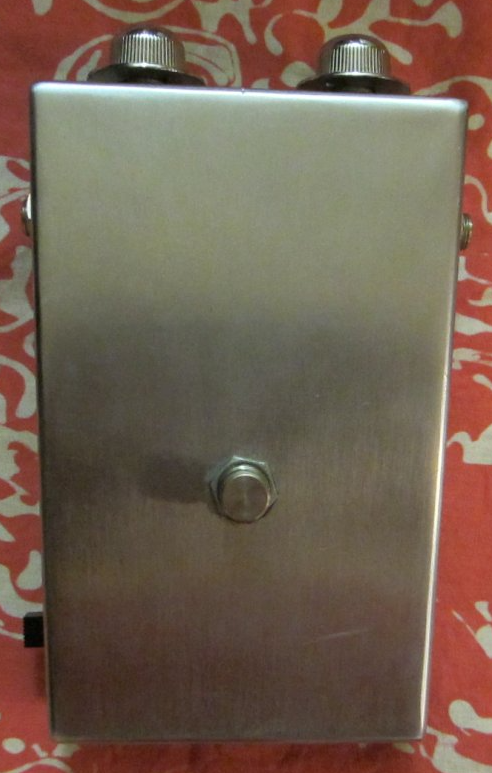
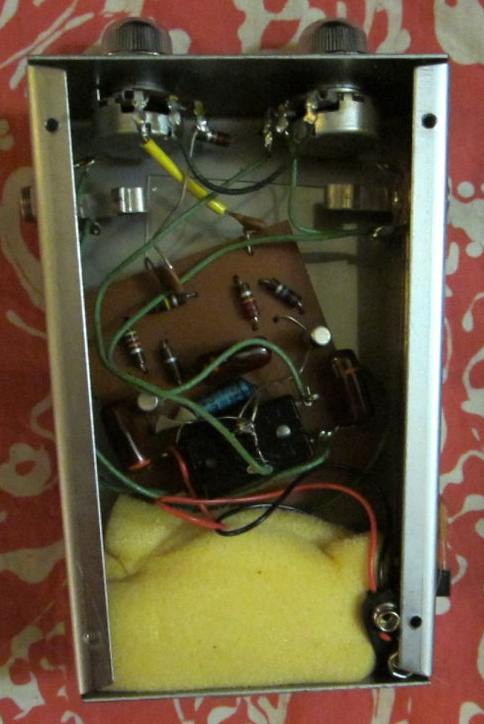
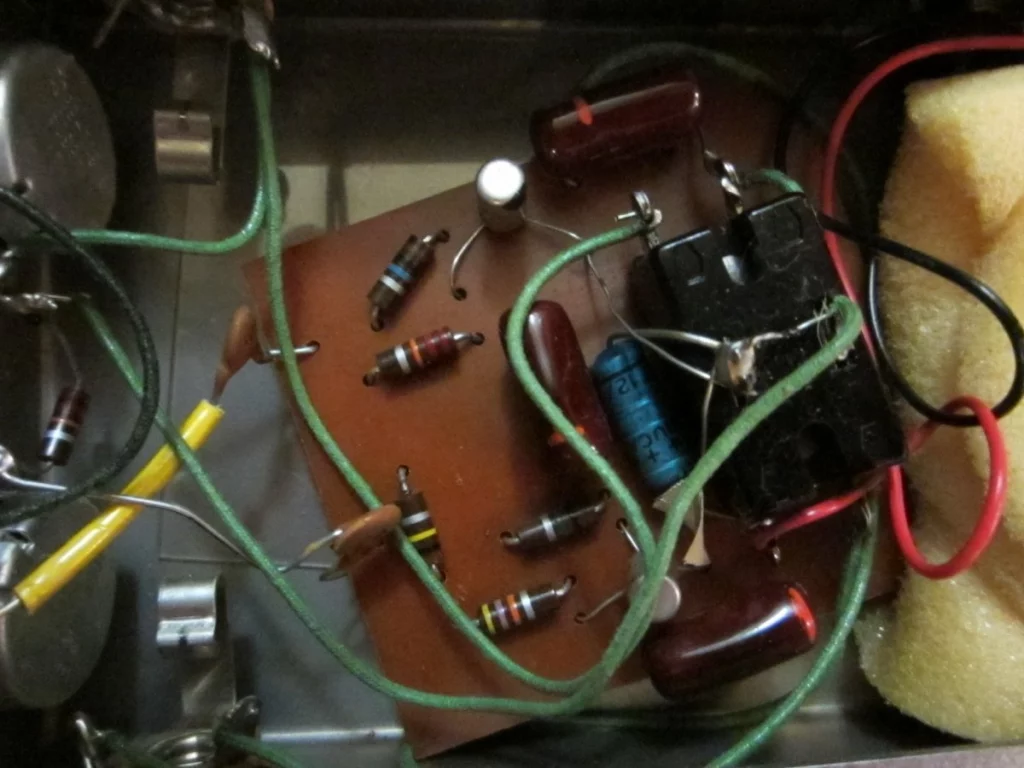
The version of the Fuzzrite that succeeded the apparently short-lived perf board Fuzzrite featured the same circuit, but differs in that the parts were assembled on a dedicated phenolic paper board. The construction style was virtually identical, in that the components were still soldered directly to one another, without the aid of any printed tracks, eyelets, or turrets on the boards. (Photo credit: Obelisk)
Early examples of this version of the Fuzzrite were built with the parts of the board facing outwards, and came with the footswitch mounted ‘through’ the board, as per on the perf board model. Fuzzrites with the parts facing outwards (sometimes described as ‘reversed’) maintained other similarities with the perf board model, such as the clear plastic spacer between the enclosure & board, and the wooden block between the footswitch & board.
The sample of known date codes stamped on the potentiometers of these ‘reversed’ phenolic board Fuzzrites range from the 15th to the 47th weeks of 1966, and the ‘reversed’ boards have thus far only ever been sighted in enclosures bearing the first & second versions of the Fuzzrite graphics. Additionally, these pedals have only been seen using the earlier Fuzzrite circuit design (i.e. germanium transistors with the moulded 100nF input/output/coupling capacitors). What all of this suggests is that Mosrite’s practice of mounting the phenolic boards in this particular fashion — with the components facing outwards — was discontinued fairly early on during the course of production.
Mosrite Fuzzrite (phenolic paper version), c. 1966-1967
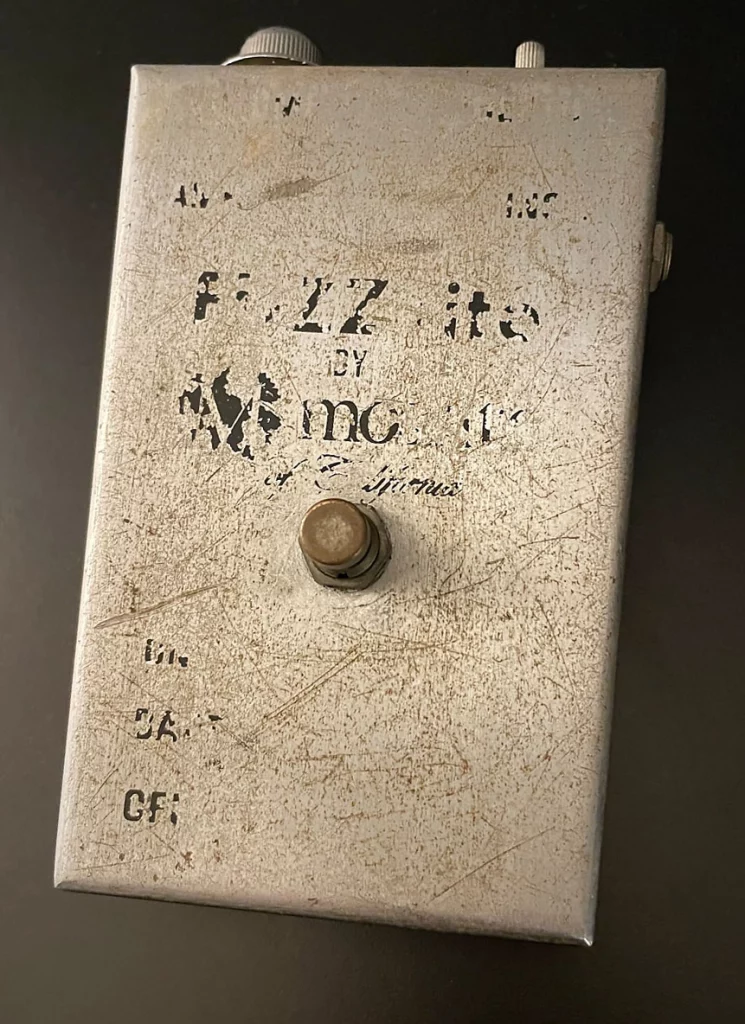
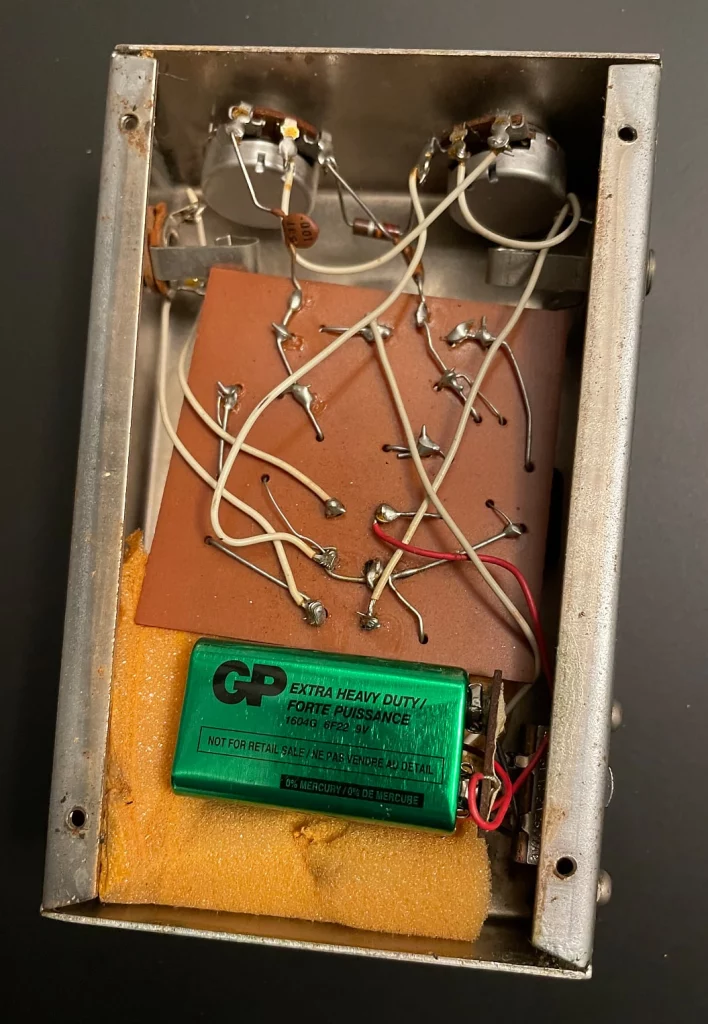
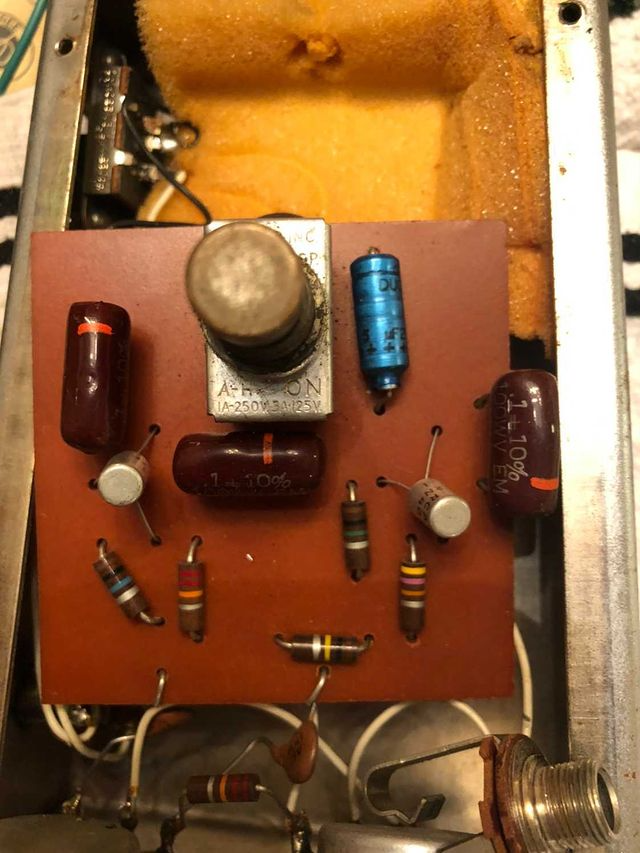
At some point in around late 1966 to early 1967, Mosrite began building Fuzzrites with the circuit board flipped around, where all of the components populating the board were positioned out of sight. This arrangement would go on to be the most commonly seen version of the germanium-transistor Fuzzrite, and was being made until around late 1967. (Photo credit: Reverb.com/contact_the_fact)
Initially, Fuzzrites built on the phenolic board (both in the aforementioned ‘reversed’, as well as in this conventional positioning) were built following the same schematic as the perf board version, but the choice of input/output/coupling capacitors changed over time. Instead of the CDE 100nF capacitors (seen in the perf board Fuzzrites), the pedals built on phenolic boards initially had red molded 100nF’s. One significant difference between this and the ‘reversed’ phenolic board (as well as the perf board) Fuzzrites is that, due to the components facing inwards, there was apparently no need to use the plastic spacer or the wooden block to isolate the electronics from the casing anymore.
This version of the Fuzzrite — built on the phenolic board, with the parts facing inwards — is statistically the most common version. It resurfaces on the vintage & used markets far more frequently than any of the other germanium-transistor Fuzzrites, and so it was presumably being manufactured for a significant period of time.
As Mosrite were building these Fuzzrites, the circuit & parts selection gradually changed. Most notably, the red moulded 100nF capacitors were eventually replaced with 50nF’s (and also briefly with 47nF’s). At least two different types of polystyrene film capacitors were used during this period of construction, but Mosrite apparently soon settled on fitting 50nF ceramic capacitors for the remainder of the run of germanium-transistor Fuzzrites, up until the following year. Examples of the regular phenolic board version of the Fuzzrite, fitted with various different sets of capacitors, are pictured below. (Photo credit: unknown/A. Souleyman/Psycho*Daisies)


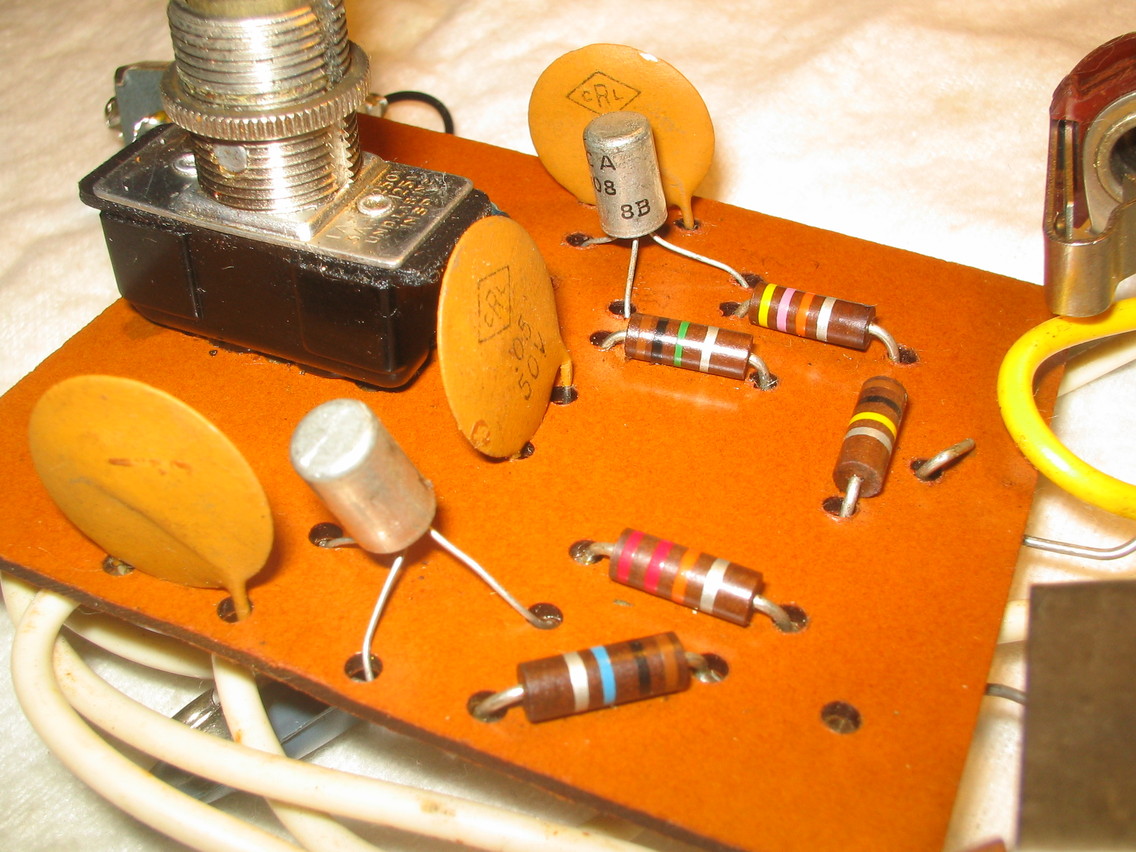
Known date codes in the pedals, built on phenolic boards with the parts on the boards facing inwards, range from the 28th week of 1966, through to the 12th week of 1967. These pedals have also been sighted in enclosures printed with all three of the Fuzzrite graphics (although there is a perfect correlation between Fuzzrites made with the 100nF input/output/coupling caps and the earlier versions of the graphics).
The range of date codes in the two versions (‘reversed’ & ‘conventional’) of the phenolic board Fuzzrites overlap slightly, and because the type of graphics on the enclosures also overlap, we can’t conclusively rule out whether the ‘reversed’ and ‘conventional’ phenolic board Fuzzrites may have in fact briefly been built in parallel, during the period of around late 1966/early 1967.
Mosrite Fuzzrite (eyelet board version), c. 1967-1968
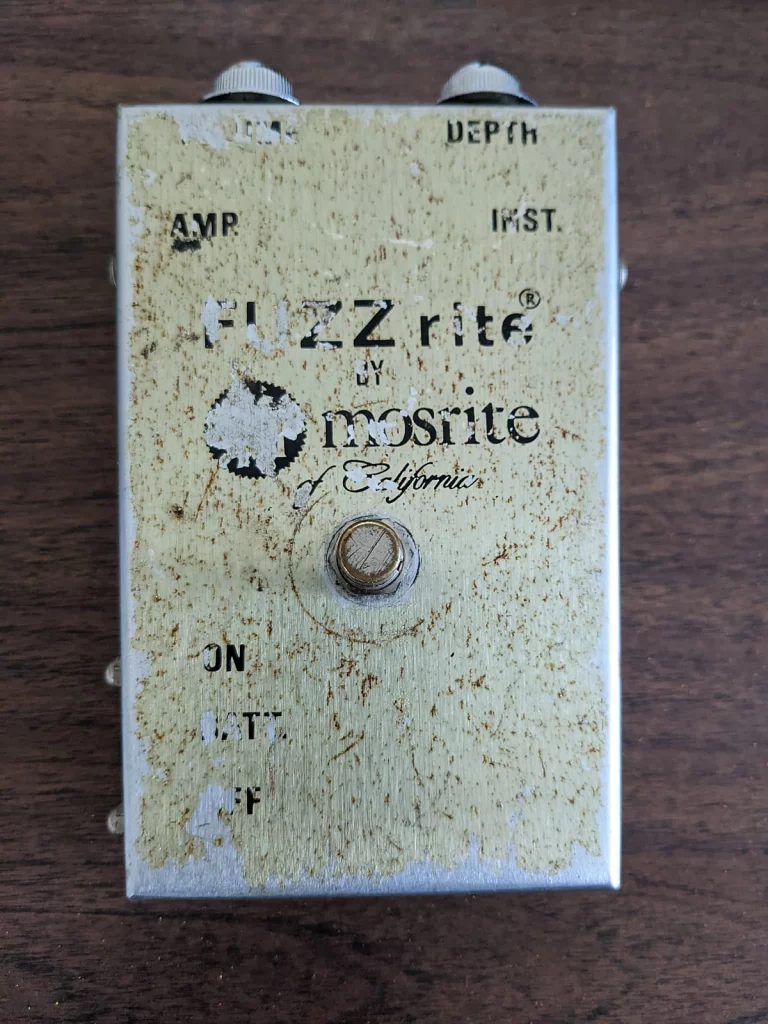

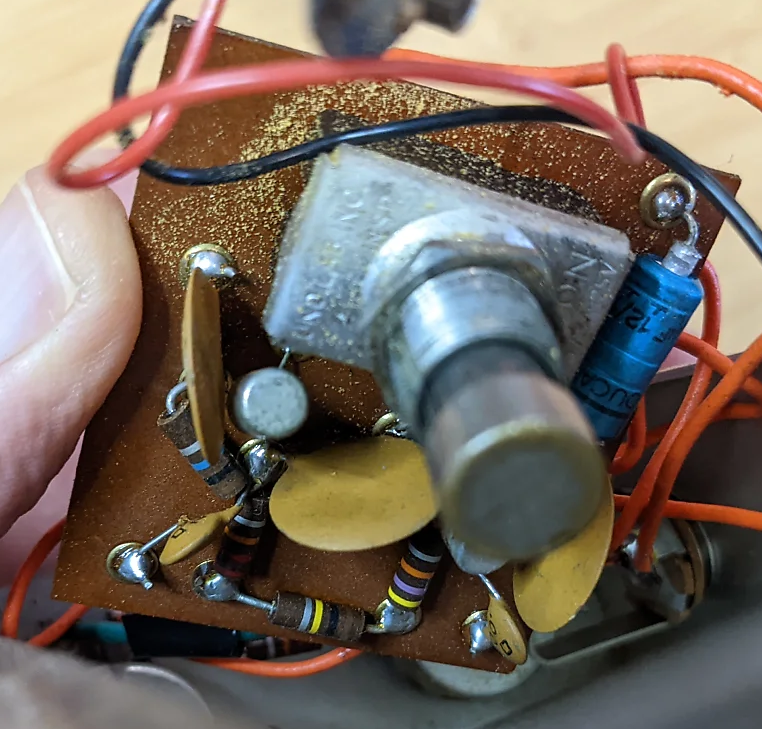
By the end of 1967, Mosrite went on to develop what would become the final version of the germanium-transistor Fuzzrite. As pictured above, for these youngest Fuzzrites, the individual components were no longer being soldered directly to one another by their leads, and instead, the Fuzzrites were being assembled on a smaller eyelet board. (Photo credit: Reverb.com)
One particular surviving eyelet board Fuzzrite has had the date ‘12/67’ crudely engraved into its battery cover, and this information reveals the time by which the model was already available in the shops. What further solidifies the position of these eyelet board Fuzzrites towards the latter part of the timeline is the fact that the pedals only ever surface using the youngest version of the germanium Fuzzrite schematic (i.e. with 50nF input/output/coupling capacitors), and that they have only ever been sighted in enclosures bearing the third version of the Fuzzrite graphics (with the ‘®’ symbol).
For a brief period during production of the eyelet board Fuzzrite, Mosrite used CTS potentiometers (prefix ‘137’). These CTS pots date to 1965, and this has led to some confusion when dating vintage Fuzzrites. Features of the eyelet board Fuzzrite such as the ceramic 50nF input, output & coupling capacitors, the black plastic footswitch, and the ‘®’ symbol on the graphics, are all consistent with the youngest of the ‘paper phenolic’ Fuzzrite (dating to 1967). Additionally, there are identical Fuzzrites built on eyelet boards that were fitted with the typical Centralab potentiometers from a different parts supply, and those potentiometers have date codes ranging between the 1st & the 10th weeks of 1968.
Even though some germanium Fuzzrites were fitted with potentiometers from 1965, the pedals themselves are completely identical to others built during the period between late 1967 and early 1968. There is no evidence to suggest that the Fuzzrite existed prior to 1966, and the date codes from surviving vintage pedals reveal that Mosrite were still building Fuzzrites with the germanium-transistor circuit at least by March 1968.
The two Fuzzrites above are the later variety of the germanium-transistor model, and have both been assembled on the eyelet board. The only difference between them is that the unit on the left (photo credit: J. Reeves & M. Seppi) has been fitted with CTS potentiometers dating to 1965, while the unit on the right has the typical Centralab pots, dating to early 1968, and which follow the established sequence of date codes in Fuzzrites. The presence of 1965-dated potentiometers in Fuzzrites of this variety does not suggest that this pedal was built before 1966, because everything else about the pedal is consistent with the models built around 1967 to 1968.
Mosrite Fuzzrite (silicon transistors), 1968
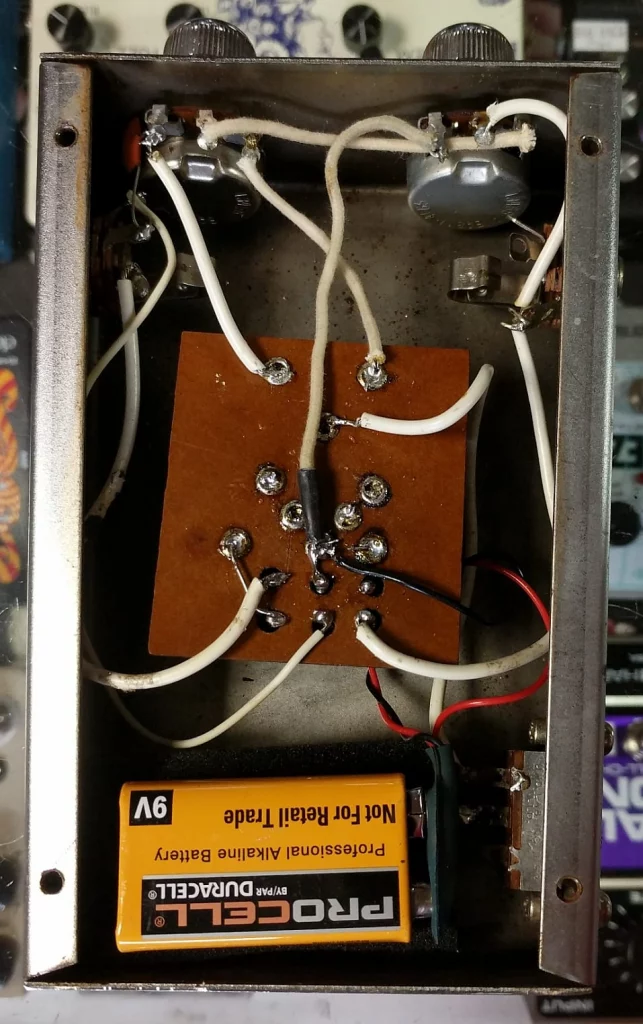
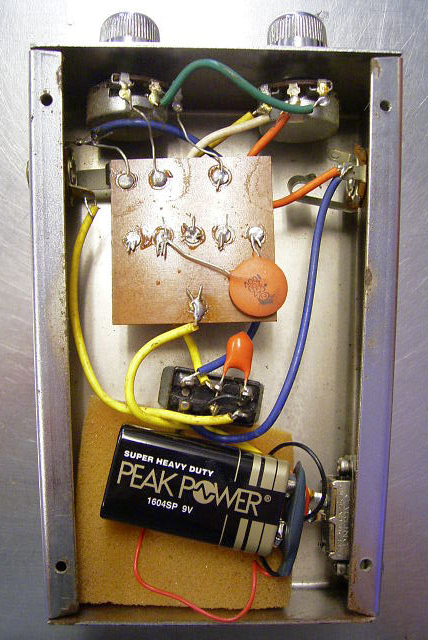
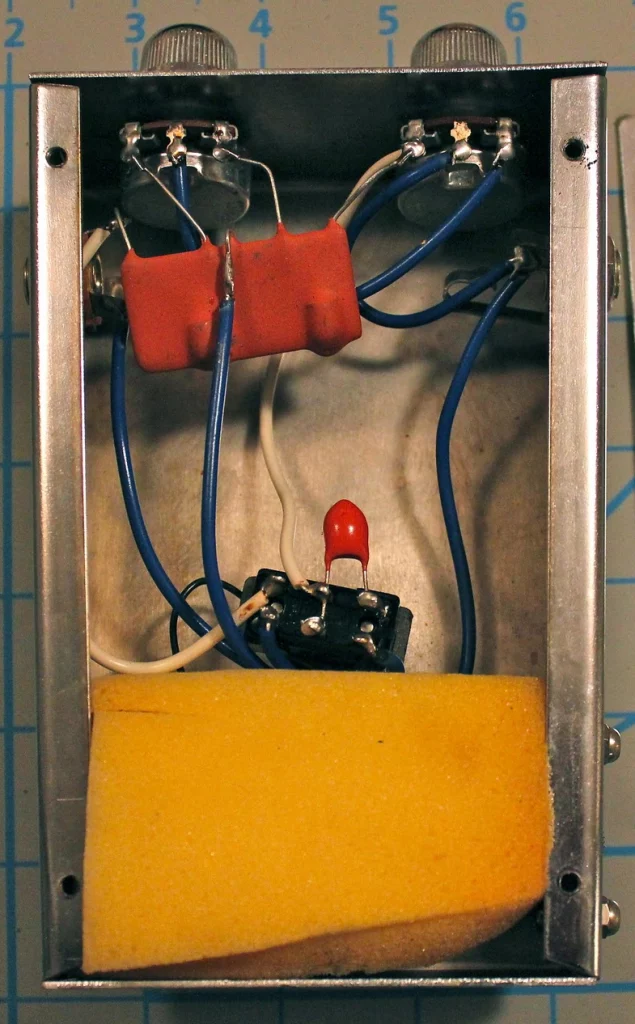
The germanium Fuzzrite was discontinued in 1968, and replaced with a silicon-transistor version of the same circuit. Silicon Fuzzrites were manufactured in very large quantities, in a relatively short space of time. Not only were these Fuzzrites built from a different schematic to the germanium-transistor models in previous years, but it was in around this time when Mosrite began fitting taller control knobs to their pedals (in place of the shorter knobs, with ‘V’ & ‘T’ markings).
The earliest silicon Fuzzrites (in the first picture above) were built with the same construction style as the last of the germanium units, where the components were assembled on an eyelet board, upon which the footswitch was mounted too. A small handful of these early silicon-transistor Fuzzrites confusingly still came with the shorter Mosrite control knobs (with ‘V’ & ‘T’ markings), which makes it sometimes difficult to tell apart from germanium versions, without inspecting the electronics inside.
Later silicon Fuzzrites (pictured second, above) were built on similar eyelet boards, but these differed from the earlier silicon model in that the footswitches were no longer being mounted directly to the circuit boards. A large stash of apparently ‘new old stock’ eyelet boards of this type were supposedly uncovered by Andy Moseley in more recent years (along with leftover Fuzzrite enclosures), and Moseley went on to assemble and sell these pedals decades after the original production run. Many of the surviving Fuzzrites with this type of construction were actually only built & sold in the 21st century.
Another version of the 1968 silicon-transistor Fuzzrite was built by a combination of Mosrite and Sprague (who supplied the electronics). It’s unclear whether these Fuzzrites, with their circuits encased in orange ‘modules’, were direct successors to the Fuzzrites built on eyelet boards, or perhaps whether they were built in conjunction for a while. Date codes on Sprague’s orange encapsulated circuits show that they were already being supplied to Mosrite by July 1968, and that production continued at least until October of that year.
The graphics of the enclosures of these silicon-transistor Fuzzrites remained unchanged throughout 1968, and as a result, it is usually impossible to tell the different versions apart without removing the bottom plates to examine the internals.
Guild Foxey Lady (Mosrite version)
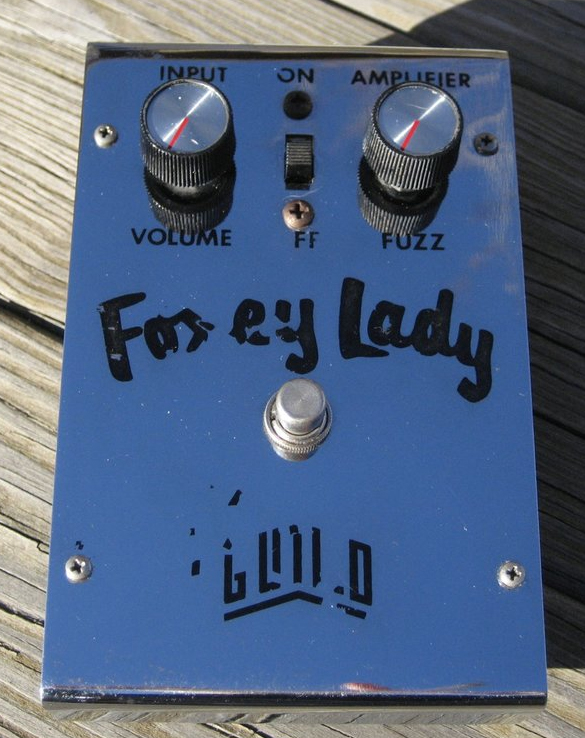
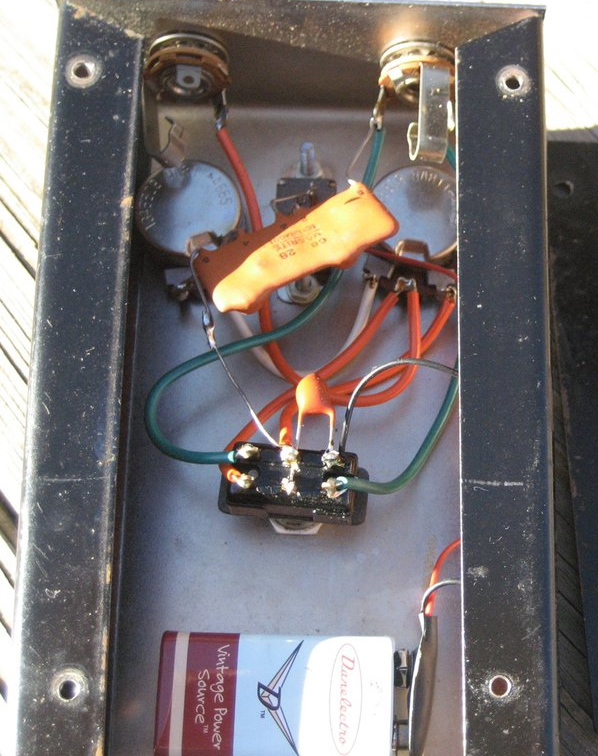
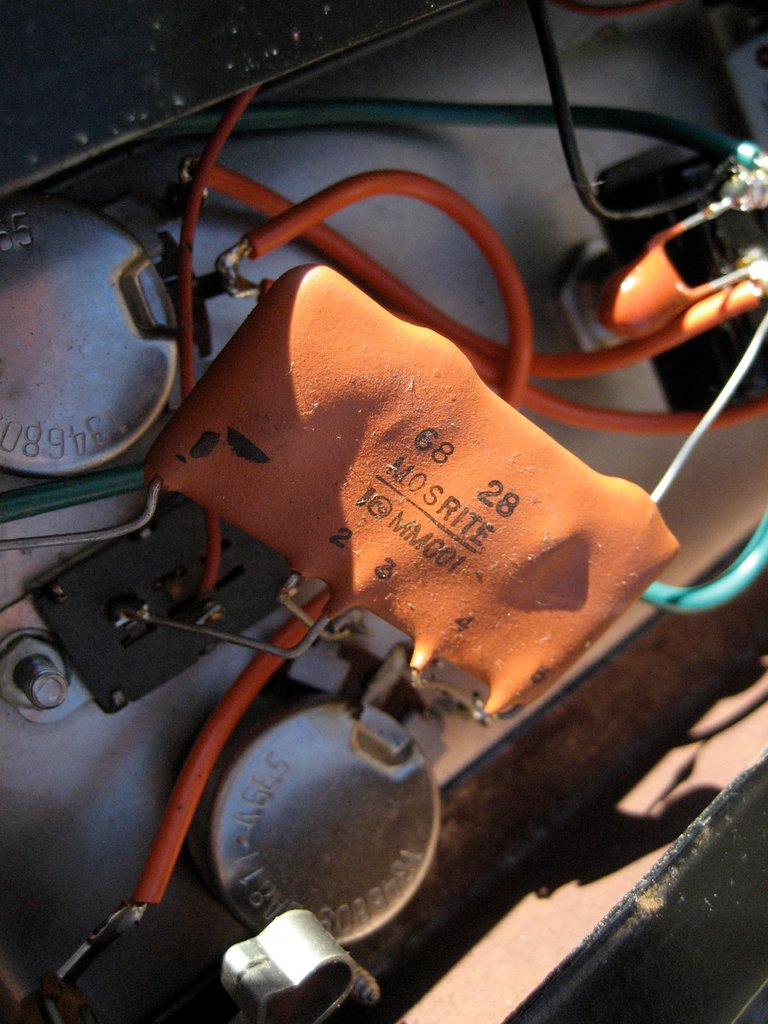
In 1968, Mosrite supplied their silicon-transistor Fuzzrite to the Guild guitar company, as the OEM. These Fuzzrites were rebranded as Guild Foxey Lady pedals, and were built with slightly different housings & control placements, but were otherwise identical to Mosrite’s product. The circuitry inside the Mosrite version of the Guild Foxey Lady was made up using the same orange encapsulated Sprague module that Mosrite were using on their own version of the pedal. (Photo credit: L. Fetterolf)
Dating these Mosrite-built Foxey Lady pedals has long been a point of contention, but close inspection of surviving exemplars provides us with date codes both on the potentiometers, as well as on the orange encapsulated Sprague circuits, that prove that this version of the Foxey Lady cannot have been built earlier than mid-1968.
Production numbers
The exact number of Fuzzrites that were built by Mosrite during their initial run between 1966 and 1968 will likely never be known exactly. It is fairly safe to say, however, that because the original germanium-transistor Fuzzrites resurface on the used market at roughly the same rate as the 1968 silicon-transistor model, production numbers of the germanium Fuzzrite were probably similar. After all, the germanium Fuzzrite was also in production for a lot longer than the silicon version was (with the latter having only been developed in 1968, shortly before Mosrite’s bankruptcy).
A very large proportion of 1960s-era fuzz boxes have not survived over the decades. The steel enclosures of the Fuzzrites were particularly susceptible to rusting, and the proximity of the pedal’s battery to the circuit board, particularly in the germanium Fuzzrites, meant that there was also a risk of ruining the electronics if a battery was left to leak inside for too long. The Fuzzrites that have not only survived, but that have also resurfaced on the Internet, make up a very small proportion of all that were ever manufactured. Certainly, there were more than 200-250 germanium Fuzzrites built, because at the time of writing, I already have photos of 91 surviving examples of the model.
Future of the Fuzzrite
Mosrite went bankrupt in late 1968, and formally ceased doing business by 1969,6 but this was not the end of the Fuzzrite. The various people who were involved with the development and the production of this fuzz box branched off and continued making variations upon it over the years that followed. By the time that Mosrite closed down, the Fuzzrite had also already spawned imitations by other companies, which continued to build & sold around the United States.
Fuzz boxes with circuits based off both the germanium and the silicon-transistor versions of the Fuzzrite are even still being built by professionals and by hobbyists to this day.
Sierra & Rosac Electronics
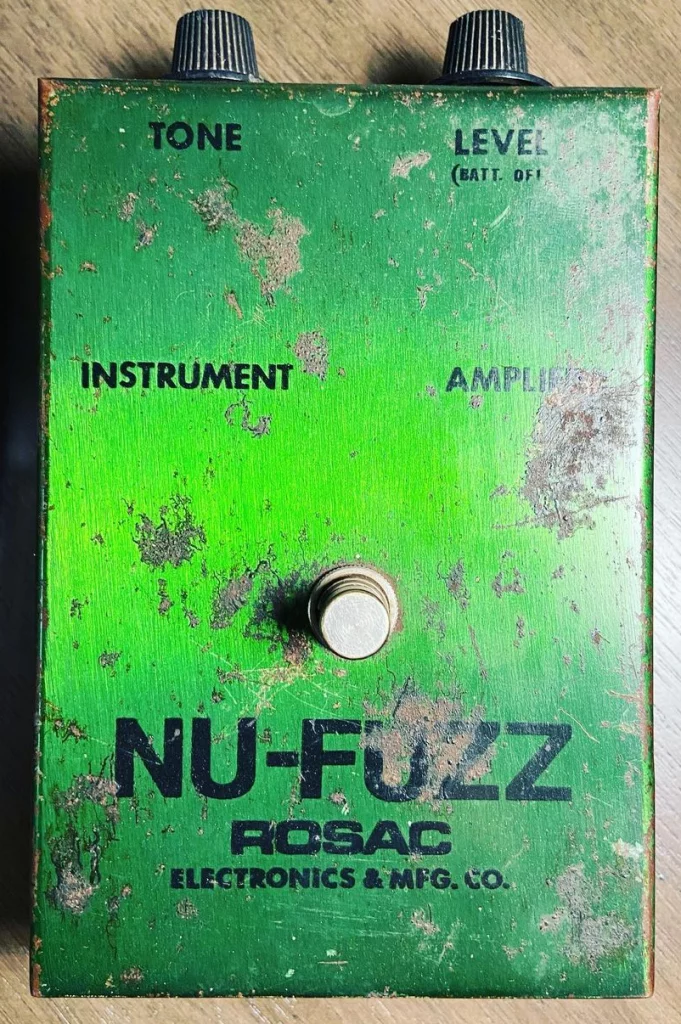

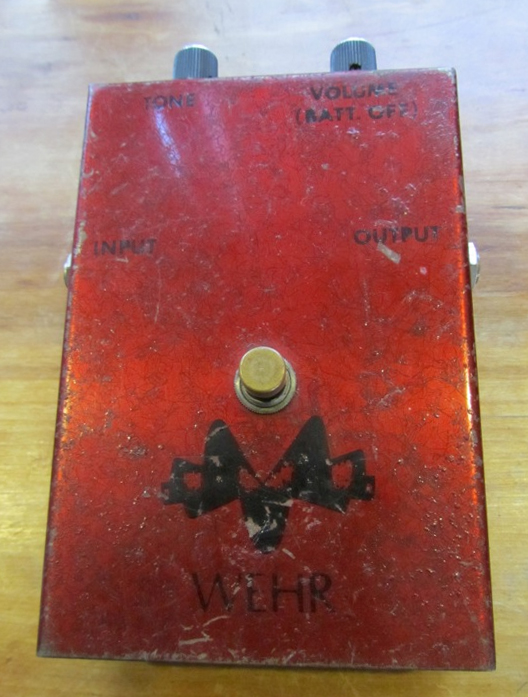
Despite Mosrite’s bankruptcy, Ed Sanner’s work in music electronics was far from finished. Sanner released a variation on his original Fuzzrite design, called the ‘Nu-Fuzz’, which was built by Sierra Electronics (and later Rosac Electronics) in reasonable quantities through the 1970s. These Nu-Fuzz circuits were based on the silicon-transistor Fuzzrites, however they featured a tone filter control instead of the depth control. (Photo credits: J. Reeves; unknown; A. Wolf)
The Sierra & Rosac fuzz boxes came finished in a multitude of different colour schemes, and were seemingly built in fairly large quantities during the 1970s. Construction of these pedals was similar to the later Fuzzrites, in that some Nu-Fuzzes were built on eyelet boards, while others were fitted with orange prefabricated Sprague modules.
A short-lived fuzz box was briefly offered by Don Wehr’s Music City in San Francisco, as pictured above, but these were simply rebranded Rosac Nu-Fuzzes. Only a handful of these Wehr fuzz pedals have been discovered thus far, and it’s possible that there were other companies & shops for whom Rosac acted as an OEM during the late 1960s through the 1970s.
Rosac also offered a more sophisticated version of the Nu-Fuzz, which was called the ‘Distortion Blender’. This model boasted an extra gain stage, along with the ability to mix in the clean guitar signal alongside the fuzz effect.
A more general history of Rosac Electronics was excellently documented by Bart Provoost on the Effects Database.
In recent years, Ed Sanner has once again been making Nu-Fuzz pedals from his home in Bakesfield, OH.
Moseley pedals

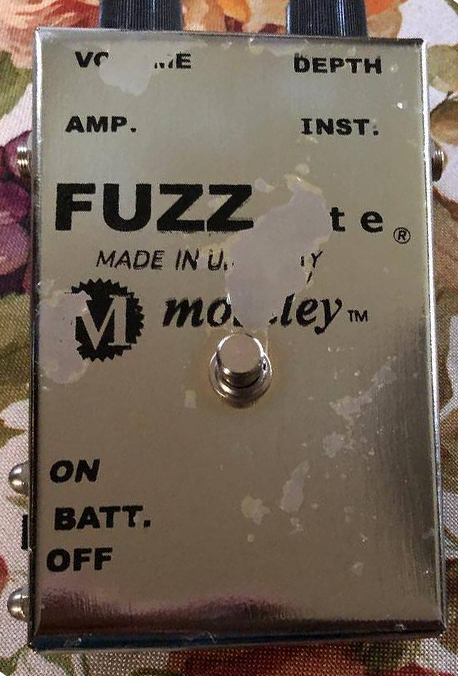

A small handful of silicon-transistor Fuzzrites have resurfaced bearing Semie Moseley’s name. Some of these pedals are almost indistinguishable from ordinary late-production Fuzzrites, other than the inclusion of Semie’s name in small print above the foot switch (as in the first photo above). Other examples appear to have been fully rebranded as ‘Moseley’ products, instead of ‘Mosrite’. A likely explanation for all of these pedals is that they were assembled in the early 1970s from an infamous stash of parts that were acquired by auction, following Mosrite’s bankruptcy.7 (Photo credits: A. Tober; unknown; B. Shade)
Aul Instruments fuzz
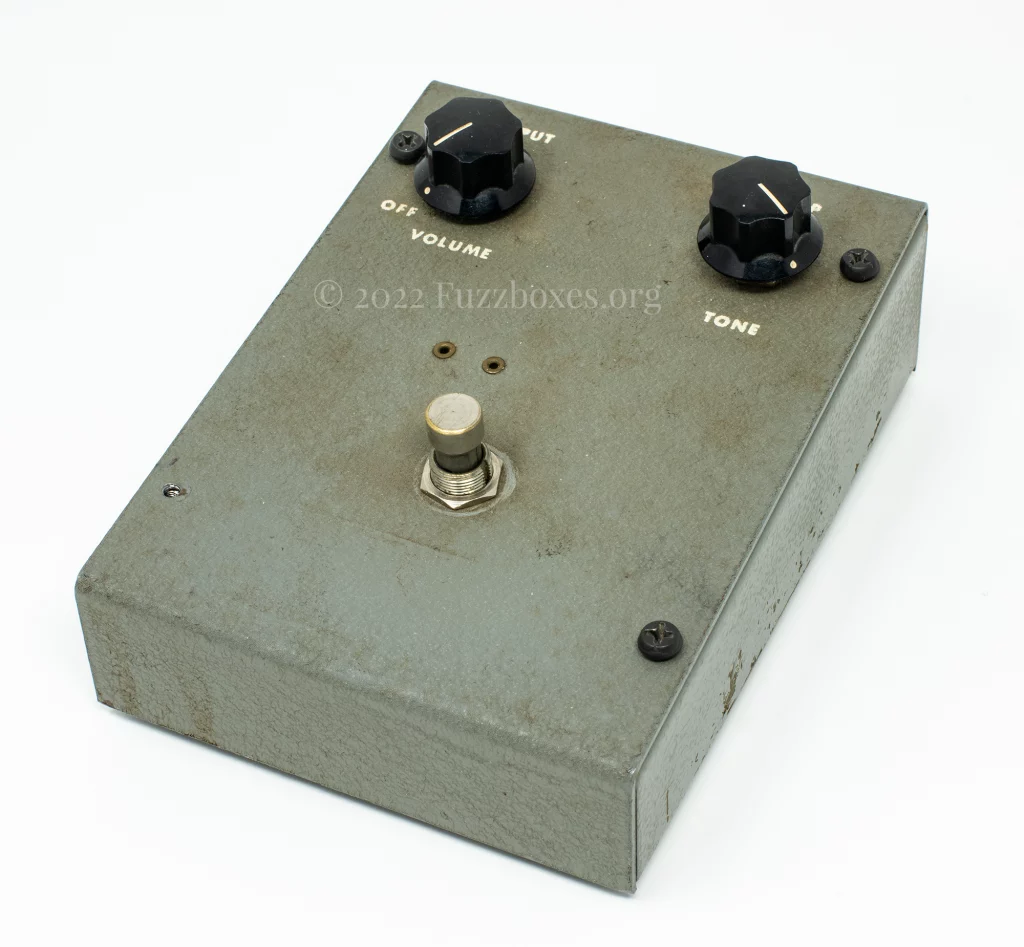
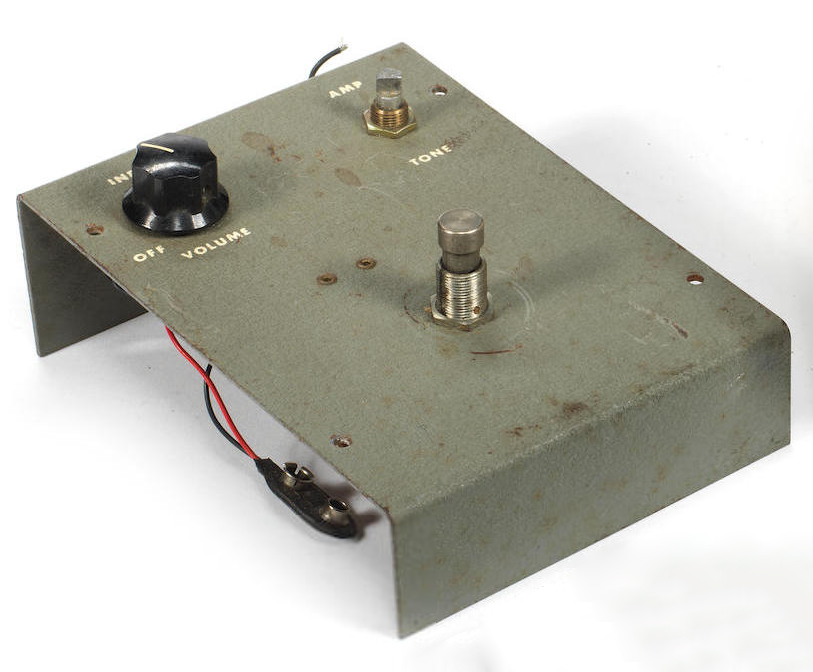
The Mosrite Fuzzrite also inspired what would turn out to be a very early Mike Matthews product (well before he launched the now-famous Electro-Harmonix company). These non-descript greenish-grey fuzz boxes were reportedly designed by Bill Berko, and the manufacturing was contracted to a local firm called Aul Instruments.8 These obscure pedals (nowadays referred to as Aul fuzzes) were similar in design to the early germanium-transistor Fuzzrite, except that they were fitted with unmarked metal-can silicon transistors.
The only known notable musician to have used one of these early Aul pedals was Jimi Hendrix, who was photographed in August 1968 at the Record Plant recording studio in New York, by Eddie Kramer, with a pair of them scattered on the floor. The remains of one Aul pedal (pictured second, above) was even discovered in recent years, as part of Mitch Mitchell’s estate, and was sold by Bonham’s in 2014.
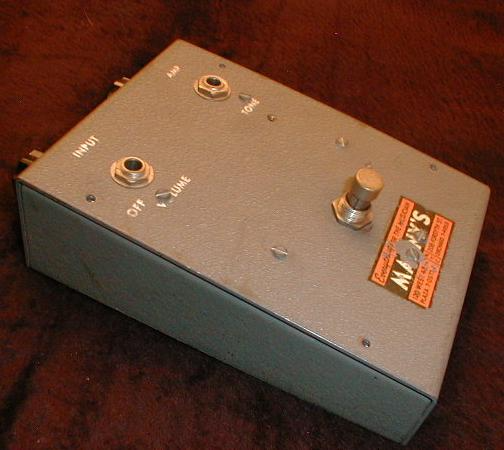

As pictured above, some of these Aul pedals have resurfaced bearing Manny’s stickers on their enclosures, which is also consistent with Mike Matthews’ own recollections about supplying the famous music shop with his early fuzz boxes.9 Other pedals were formally branded for the Guild guitar company, after a deal was made with Matthews. These pedals were named Foxey Lady by Al Dronge (founder of Guild guitars), hoping to capitalise on Jimi Hendrix’s hit single.10
Given that Jimi Hendrix was already recording with an Aul fuzz by August 1968, and that the Mosrite version of the Guild Foxey Lady certainly wasn’t being built until mid-to-late 1968, it is likely that Mike Matthews’ early dealings with Guild — supplying the company specifically with the above Aul-built Foxey Lady pedals — predate those done between Guild & Semie Moseley’s company.
Electro-Harmonix pedals
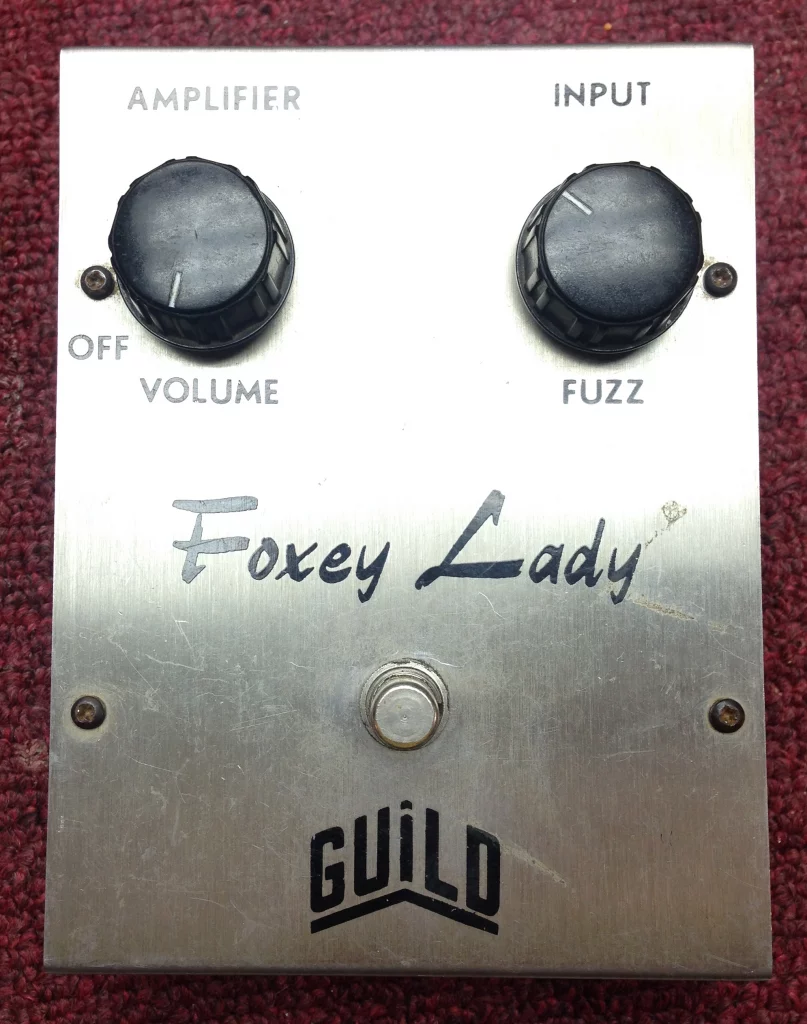


By late 1968, Mike Matthews had formally launched the now-famous Electro-Harmonix (EHX) guitar effects company.11 One of EHX’s earliest products was a newer version of the Guild Foxey Lady. These pedals were quite clearly based upon Matthews’ earlier Aul fuzz pedal. The basic electronic circuit was very similar (which originated in the Mosrite Fuzzrite), and the only significant change to the aesthetics of the pedals was that the casings came in bare brushed steel, as opposed to being painted in the Aul greenish-grey wrinkle finish. (Photo credits unknown)
Date codes stamped onto the potentiometers fitted to the earliest of the EHX-built Guild Foxey Lady pedals date to late 1968. It has been theorised that Mike Matthews began supplying Guild with fuzz boxes as a direct result of Mosrite’s bankruptcy, and the date codes on these early EHX-built pedals are consistent with that logic. What the wider evidence around EHX, Guild & Aul pedals suggests, however, is that the Aul fuzz (earliest version of Mike Matthews’ fuzz box) was built & supplied to Guild prior to the rebranded Mosrite pedals, and the Guild Foxey Lady pedals in the brushed steel enclosures (built by the newly-founded Electro-Harmonix) came after the Mosrite-built model.
Foxey Lady pedals continued being built by Electro-Harmonix, with the same Fuzzrite-inspired design, until the early 1970s (again, according to date codes on surviving pedals). Eventually Electro-Harmonix redesigned the Foxey Lady, and began supplying them to Guild using their highly successful Big Muff π (Pi) circuit instead.
Finally, another short-lived Electro-Harmonix pedal, which seemed to be contemporaneous to the Guild Foxey Lady pedals (dating to around 1970) featured the same Fuzzrite-inspired circuitry. Pictured last, of the above images, these pedals were formally branded as Electro-Harmonix Axis pedals. It is likely that EHX discontinued the Axis pedal in place of their newly-designed Big Muff π.
Obscure east coast fuzz
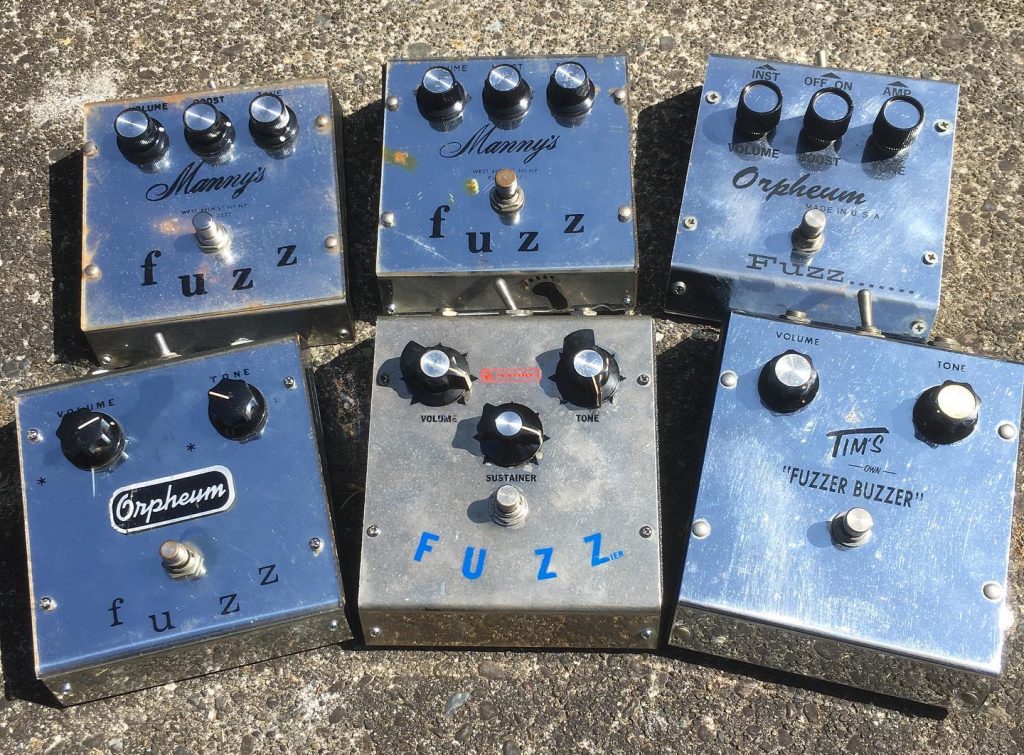
The pedals pictured above were all seemingly built by the same company, and they all feature electronic circuits derived from the original Mosrite Fuzzrite design. Some of these pedals were built with silicon transistors, and others were built with germanium transistors, and the date codes on surviving pedals suggest that they were being made during the late 1960s. The enclosures were made from a combination of folded metal and wood. Some models were fitted with a transparent protective screen over the graphics on the casings. (Photo credit: J. Roth/Jermsfuzz)
These fuzz boxes were branded for a variety of different companies. Some of these pedals are exceedingly rare, and it is quite likely that as time goes on, we may continue to discover even more variants. The models known thus far are as follows:
- Manny’s Fuzz — Manny’s Music (New York)
- Orpheum — a historic brand, owned during the 1960s by Maurice Lipsky Music Co. (New York)
- Andre Fuzzier — founded by Gene Andre (New Jersey)
- Clark SS-600 Fuzz — Clark Music Industries (New Jersey)
- E.U. Wurlitzer [Tim’s own] Fuzzer Buzzer — E.U. Wurlitzer Music and Sound (Boston)
- Gracin’s Fubar — may have been branded for Bernie Gracin’s chain of music stores (New York), but unconfirmed
- Gilsonite — Gilsonite Music Industries (New Jersey)
- AAT Fuzzier — unknown
- MGI — unknown
- Mica-Tone Fuzz — unknown
- Halifax Fuzz — unknown
The exact origins of this family of fuzz are still unknown, but the other feature that ties many of them together, is that they were seemingly branded for companies & shops on the American east coast. Clark-branded fuzz boxes have come with ident stickers claiming responsibility for distribution and the manufacturing of them, and so one possible explanation is that these Fuzzrite copies came from New Jersey.
Many thanks to Jim Roth/Jerms for helping me acquire my very first vintage Fuzzrite, over a decade ago, and for having the foresight to stockpile an impressive assortment of Fuzzrites & Fuzzrite-related pedals.
Thanks to Bart Provoost for doing the early research into Rosac & Manny’s/Orpheum/etc. pedals.
Thanks to Jeremy Reeves & Antti Karttu for sharing an endless enthusiasm about these obscure fuzz pedals.
- Price, Robert [https://web.archive.org/web/20080712034122/http://www.bakersfield.com/static/FP/baksound/mosrite.htm]
- Shade, Bob [http://www.hallmarkguitars.com/pedals/nu-fuzz.shtml]
- Halterman, Del, Walk-Don’t Run – The Story of The Ventures, Lulu, 2009, p. 134
- Halterman, Del, Walk-Don’t Run – The Story of The Ventures, Lulu, 2009, p. 134
- http://www.dominocs.com/Library/FuzzriteQA.html
- Price, Robert [https://web.archive.org/web/20080712034122/http://www.bakersfield.com/static/FP/baksound/mosrite.htm]
- Andy Moseley, interviewed by Tym Guitars [unknown date]
- Mike Matthews, interviewed by Ron Neeley [unknown date]
- Guitarist (Jamie Dickson), Interview: Mike Matthews (Electro-Harmonix founder), May 2012
- Guitarist (Jamie Dickson), Interview: Mike Matthews (Electro-Harmonix founder), May 2012
- https://www.ehx.com/the-ehx-story/
